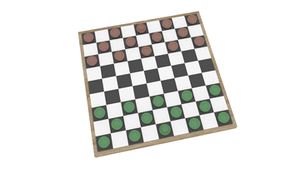Draughts
- This article is about the Sahar version of the game. For the version found on Earth, see Draughts.
 Starting position for Kinged Kaseh on an 9×9 draughts board | |
| Years active | at least 2,000 |
|---|---|
| Genre(s) | Board game Abstract strategy game Mind sport |
| Players | 2 |
| Setup time | <1 minute |
| Playing time | 30 minutes – 2 hours |
| Random chance | None |
| Skill(s) required | Strategy, tactics |
| Synonym(s) | Checkers, Byonam |
Draughts, also known as Checkers, Vaniuan Draughts, Vaniuan Checkers, or Byonam, is a very popular kind of board game found mainly in Vaniua, which involves two players moving a set of uniform cylindrical game pieces and capturing by jumping over opponent pieces. Draughts developed from an ancient Ohanian board game called Qakakun.
The most popular forms are Vucuna, Kaseh, and Cheno, all played on an 9×9 checkerboard. There are many other variants played on 9×9 boards.
General rules
Draughts is played by two opponents, on opposite sides of the gameboard. One player has the dark pieces; the other has the light pieces. Players alternate turns. A player may not move an opponent's piece. A move consists of moving a piece diagonally to an adjacent unoccupied square. If the adjacent square contains an opponent's piece, and the square immediately beyond it is vacant, the piece may be captured (and removed from the game) by jumping over it.
There are several possible starting arrangements in draughts, but the so-called "Scattered" arrangement, where only the dark squares of the checkered board are used, is the most popular. A piece may move only diagonally into an unoccupied square, however if a piece is on the board's center square, it may move an extra square diagonally. When presented, capturing is optional in most official rules, although some rule variations make capturing mandatory. In most variants, the player without pieces remaining, or who cannot move due to being blocked, loses the game.
Men
Uncrowned pieces (Men) move one step diagonally forwards, and capture an opponent's piece by moving two consecutive steps in the same line, jumping over the piece on the first step. In most variations of draughts, men can jump both forwards and backwards. In Kaseh, multiple enemy pieces can be captured in a single turn provided this is done by successive jumps made by a single piece; the jumps do not need to be in the same line and may "zigzag" (change diagonal direction).
Kings
Kings have a variety of different quirks depending on the game being played. In kingless variations of Vucuna and Kaseh, kings aren't used at all. But in the versions that do, King's Vucuna and Kinged Kaseh, they are brought into the game differently. In King's Vucuna, when a man jumps onto a space containing a crown piece, it becomes a king, and is marked by placing the crown piece on top of the man in question. In Kinged Kaseh and Cheno, the king is there from the very start, and their objective is to capture the opposing king. Except in Cheno, kings also acquire the ability to move any distance among unblocked diagonals, and may capture an opposing man any distance away by jumping to any of the unoccupied squares immediately beyond it.